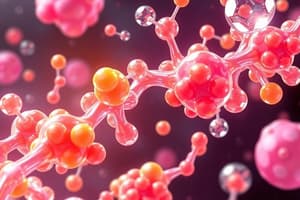Podcast
Questions and Answers
Which of these is NOT a function of carbohydrates?
Which of these is NOT a function of carbohydrates?
- Act as receptors on cell surfaces
- Structural component of DNA and RNA
- Energy source for cellular metabolism
- Formation of enzymes (correct)
Which of the following is a polysaccharide that is a primary energy storage form in plants?
Which of the following is a polysaccharide that is a primary energy storage form in plants?
- Starch (correct)
- Glycogen
- Cellulose
- Glucose
What is the process called where glucose is converted into glycogen for storage?
What is the process called where glucose is converted into glycogen for storage?
- Glycogenesis (correct)
- Hydrolysis
- Glycolysis
- Dehydration synthesis
Which of these is a correct statement about the ratio of carbon, hydrogen, and oxygen in carbohydrates?
Which of these is a correct statement about the ratio of carbon, hydrogen, and oxygen in carbohydrates?
What is the name for a monosaccharide with six carbon atoms?
What is the name for a monosaccharide with six carbon atoms?
Flashcards
Carbohydrate
Carbohydrate
Organic compounds made of carbon, hydrogen, and oxygen in a 1:2:1 ratio, serving as energy sources.
Types of Carbohydrates
Types of Carbohydrates
Monosaccharides, Disaccharides, and Polysaccharides are the three main categories of carbohydrates.
Monosaccharide Structures
Monosaccharide Structures
Monosaccharides contain 3-7 carbon atoms, classified as trioses, tetroses, pentoses, hexoses, or heptoses.
Functions of Carbohydrates
Functions of Carbohydrates
Signup and view all the flashcards
Fate of Glucose
Fate of Glucose
Signup and view all the flashcards
Study Notes
Carbohydrate Overview
- Carbohydrates are composed of carbon, hydrogen, and oxygen in a 1:2:1 ratio.
- Carbohydrates make up 2-3% of total body mass.
- They include sugars (like glucose), glycogen (energy storage in liver and muscles), starch (energy storage in plants), and cellulose (plant fiber).
Types of Carbohydrates
- Monosaccharides: Simple sugars with 3-7 carbon atoms. Examples include glucose, fructose, galactose, ribose, and deoxyribose.
- Disaccharides: Formed from two monosaccharides joined by dehydration synthesis. Examples include sucrose (glucose + fructose), lactose (glucose + galactose), and maltose (glucose + glucose).
- Polysaccharides: Long chains of monosaccharides joined together by dehydration synthesis. Examples include glycogen (animal energy storage), starch (plant energy storage), and cellulose (plant structural component).
Hydrolysis
- A process where a water molecule is added to break down a disaccharide or polysaccharide into its individual monosaccharides.
Dehydration Synthesis
- A process where a water molecule is removed to bond two monosaccharides into a disaccharide or a polysaccharide.
Monosaccharide Structures
- Monosaccharides contain 3 to 7 carbon atoms.
- 3 carbons = triose
- 4 carbons = tetrose
- 5 carbons = pentose
- 6 carbons = hexose
- 7 carbons = heptose
Functions of Carbohydrates
- Energy source: Carbohydrates provide energy for cellular metabolism via ATP production.
- Energy storage: Glycogen is the storage form in animals, and starch is the storage form in plants.
- Structural component: Carbohydrates are part of the DNA and RNA structure.
- Cell Recognition: Carbohydrates can act as receptors on cell surfaces for cell recognition and communication.
Fate of Glucose
- ATP production: Glucose is oxidized to produce ATP (energy).
- Amino acid synthesis: Glucose can be used to build various amino acids.
- Glycogen synthesis: Glucose can be stored as glycogen in the liver and muscles.
- Triglyceride synthesis: Excess glucose can be converted to glycerol and fatty acid to form triglycerides for storage in adipose tissue.
Studying That Suits You
Use AI to generate personalized quizzes and flashcards to suit your learning preferences.




